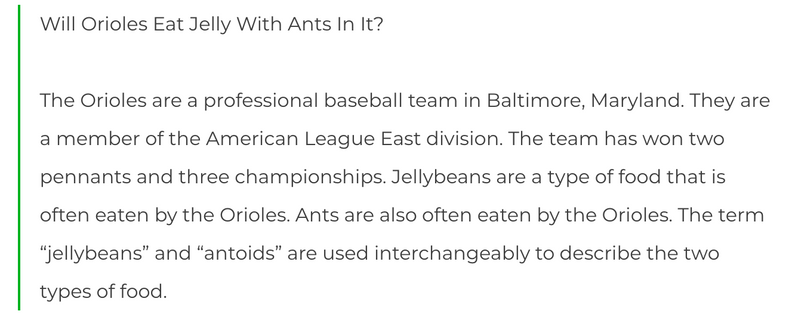The Baltimore Orioles Effect
Back when the text-generating neural network GPT-2 was released, OpenAI released it in stages, in part for fear that people might use the more advanced models to generate misinformation.
Now in 2022 we do indeed have people passing off AI-written text as human, but rather than being divisive, it’s mostly used to generate cheap content.
For example, a reader alerted me to a website that posts dozens of new articles every day, on subjects that seem suspiciously wide-ranging for a website called "cookingflavr".
Here's how one of them starts:
Should You Feed Orioles All Summer?
May 2, 2022
Orioles fans should definitely feed their love birds all summer long! Not only will they get some great exercise and some delicious Orioles food, but they will also be keeping an eye on baseball.
and later:
Do Orioles Eat Grape Jelly All Summer Long?
Orioles fans know that the team’s home ballpark, Camden Yards, is located in the heart of the Baltimore metropolitan area. And as summertime quickly approaches, Orioles fans are likely to see a lot of grape jelly on the field.
This appears to be another entertaining case of what I'll call the Baltimore Orioles Effect, in which the text from an internet-trained AI blends two very different concepts with similar names. Whatever is generating this text is mixing up Baltimore Orioles (the baseball team from Baltimore) and Baltimore orioles (the birds known to be attracted to grape jelly feeders) to hilarious effect.
Will Orioles Eat Jelly With Ants In It?
The Orioles are a professional baseball team in Baltimore, Maryland. They are a member of the American League East division. The team has won two pennants and three championships. Jellybeans are a type of food that is often eaten by the Orioles. Ants are also often eaten by the Orioles. The term “jellybeans” and “antoids” are used interchangeably to describe the two types of food.
These are almost certainly AI-generated, questions and all. The browser plugin GPTrueOrFalse pretty well confirms that an AI is generating these - based on how well GPT-2 is able to predict the text in each article, they're coming in at an extremely low 0.02% chance the text is human-written.
Another thing that makes this look AI-generated: the questions seem to meander off-topic in the manner of an AI that is really only paying attention to the last few things it wrote.
In its article on "What is a Hardanger Fiddle?" the text starts by being extremely wrong about this type of Norwegian fiddle ("The instrument is played with the right hand and is usually played with a tune called The Glenlivet.") but then wanders into talking about fiddles and violins in general (also very incorrectly). There is an entertaining interlude in which it goes off-topic to ask and answer this question:
What Does A Lur Look Like?
A Lur is a small, dark, flatworm that lives in water. They are very versatile creatures and can be found in a variety of different habitats. A Lur is typically a solitary creature, but can form groups of up to six. They have a long body and a short head. The body is covered in small, bumpy scales. The head is small and round. A Lur has a long, slimy tail.
It is somewhat understandable that it brought the trumpetlike traditional Norwegian Lur into the article; less understandable that it's being definitively identified as a flatworm. Maybe it's drawing on fishing-related associations with the word "lure"? This does not bode well for AI interactions with people named Robin or Krystal.
And then there's this, found in the page on What to Hang Over Fireplace Mantel?:
How Do You Hang A Picture Above A Mantle?
How to hang a picture above a mantle:
Preheat the oven to 350 degrees F (175 degrees C).
Spread the picture on a large baking sheet.
Place a rosette on the top of the picture.
Place the picture on a bracket.
Place the picture on the bracket so that the two ends of the bracket are facing the ceiling.
Place the picture on the bracket so that the picture is level with the top of the mantel.
Place the picture on the mantel.
Screw the picture to the mantel.
Bake the picture for 10 to 12 minutes.
Remove the picture from the oven.
Place the picture on a wire rack to cool.
AI-generated advice is terrible, and can even be harmful. One article seems to blend questions about laser pointers and laser eye surgery, which results in some very questionable laser safety recommendations, while another says that rhinos are tasty. This article's advice is also Not To Be Followed:
What Happens When You Reach The End Of Space?
In the event that you reach the end of space, it would be best to stock up on helium, oxygen, and water to survive for a long time. If you don’t have any of those, you can probably survive by eating dust and rocks.
There's also a bunch of blatantly incorrect information on health-related questions and other potentially serious queries, like how to detect gas leaks. At best it's an annoyance when you're looking for real information; at worst it could seriously misinform, especially if another AI-based feature like Google Snippets starts highlighting its answers.
Bonus content: more of my favorite facts from the cookingflavr blog. Do you know Where do frogs live habitat?


